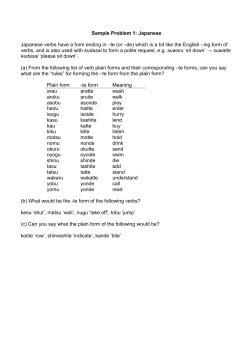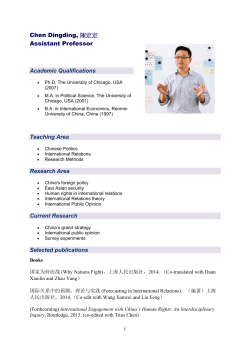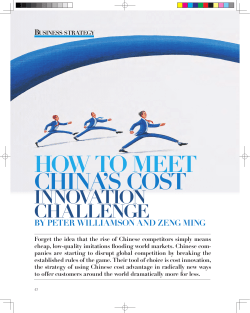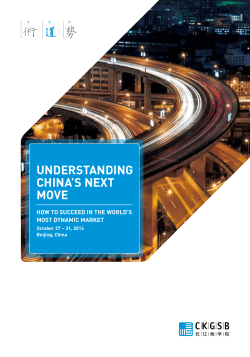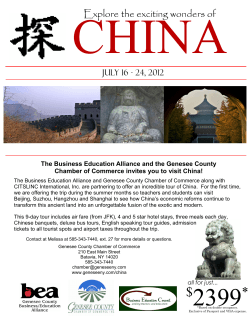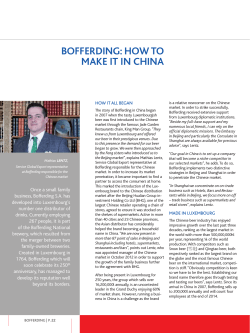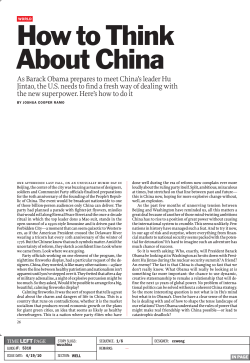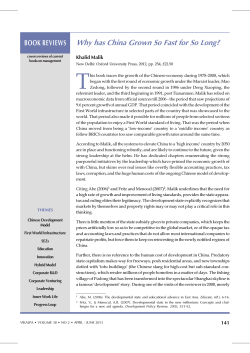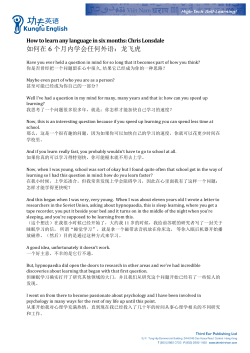
China Law International Winter Camp December 7-20, 2014 Beijing · Xi’an
China Law International Winter Camp December 7-20, 2014 Beijing · Xi’an SPONSOR: China Law Society ORGANIZER: China Legal Exchange Center Contents 1. General Information...................................................................................................... 2 2. Tentative Agenda........................................................................................................... 4 3. Registration Form ......................................................................................................... 7 4. Introduction to Lecturers............................................................................................... 8 5. Introduction to China Law Society ............................................................................. 16 6. Introduction to China Legal Exchange Center............................................................ 18 7. Why We Organize the China Law International Winter Camp................................... 20 8. Introduction to China Law International Summer Camp 2014 .................................. 22 9. Introduction to Cultural Sites...................................................................................... 29 General Information 1. The China Law International Winter Camp, a legal exchange program initiated by the China Law Society, is designed to accommodate international law school students, who are interested and have the envision to study, work or develop business in or with China. The program agenda includes specialized lectures on law, visits to legal institutions and tours of cultural sites in both Beijing and Xi’an (see the attached tentative agenda). By attending the Winter Camp, participants will not only get a general knowledge of China’s legal system, promotion of the rule of law, social and economic development as well as history and culture, but also build social contacts with Chinese legal institutions and develop friendship with international counterparts. 2. The Camp will last 14 days. Arrival of participants is Sunday, December 7 and departure is Saturday, December 20. 3. The working language of the Camp will be English. Participants are expected to have a good English proficiency for communication purpose. 4. The cost of the Camp is USD $3480 per person, which includes accommodation (one room for one person), food, local transportation (including transportation from Beijing to Xi’an, transportation to legal institutions and cultural sites), academic materials and tickets for cultural sites. Participants who remit the money before the date of October 20, 2014 can get preferential price of USD $3280. 5. The flight tickets for the international travel (arrival in Beijing Capital International Airport on December 7, 2014 and departure from Xi’an Xian Yang International Airport on December 20, 2014) have to be bought by the participants themselves. We will provide pick-up and see-off service at the airport at certain different times. 6. The deadline to apply for the Camp is October 31, 2014. Please fill out the registration 2 form (The Word Version is attached) and send it back by email. Acceptance letters will be sent out after the deadline for application. Candidates not accepted for the Camp will be informed accordingly. 7. If you have any questions, please contact Ms. Gu Ran. Tel & Fax: 0086-10-66155681 Email: lawexchange@chinalaw.org.cn Address: China Law Society, No. 63, Bing Ma Si Hutong, Xicheng District, Beijing, 100034, China 3 Tentative Agenda December 7 (Sunday), 2014 Arrive in Beijing and Register December 8 (Monday), 2014 Morning Opening Ceremony Lecture 1: The Socialist System of Laws with Chinese Characteristics Afternoon Lecture 2: China’s Reform and Opening Up Policy and the Socialist Market Economy December 9(Tuesday), 2014 Morning Lecture 3: Chinese Legal Education Afternoon Visit the School of Law of the University of International Business and Economics and Have a Discussion on Legal Education and Foreign Students’ Legal Education in China December 10 (Wednesday), 2014 Morning Classroom Discussion Afternoon Visit the Forbidden City (the Imperial Palace) December 11 (Thursday), 2014 Morning Lecture 4: Chinese Financial Law Afternoon Visit China International Economic and Trade Arbitration Commission and Have a Discussion on Arbitration System December 12 (Friday), 2014 Morning Lecture 5: Chinese Legal Service System, Legal Service Market and Foreign Lawyers’ Practice in China 4 Afternoon Visit Beijing King & Wood Mallesons Law Firm and Have a Discussion on Chinese Law Firms’ Practice December 13 (Saturday), 2014 Morning Visit the Great Wall Afternoon Visit the Summer Palace December 14 (Sunday), 2014 Morning Visit the Temple of Heaven Afternoon Visit Ancient Alleys of Beijing December 15 (Monday), 2014 Morning Lecture 6: Chinese Foreign Trade and Economic Laws Afternoon Go to Xi’an December 16(Tuesday), 2014 Morning Lecture 7: China’s Judicial System and Its Reform Afternoon Visit Xi’an Intermediate People’s Court and Have a Discussion on Trial System December 17 (Wednesday), 2014 Morning Visit Museum of Emperor Qin Shihuang’s Terra-cotta Warriors and Horses Afternoon Visit the Theme Park of Tang Dynasty December 18 (Thursday), 2014 Morning Lecture 8: Externally-oriented Economy of Shaanxi Province and Its Development Afternoon Visit Xi’an High-Tech Industries Development Zone December 19 (Friday), 2014 Morning Lecture 8: History and Culture of Xi’an 5 Closing Ceremony Afternoon Visit Xi’an Ancient City Wall December 20 (Saturday), 2014 Departure from Xi’an 6 Registration Form China Law International Winter Camp December 7-20, 2014; Beijing & Xi’an, China Please complete this form in English. Gender Name on Passport Date of Birth Passport Number (if available) Nationality Post Address (please specify street, city, state/province and country) School Name (if a student) Special Requirements for Food or Other Aspects Tel Major Fax Grade Mobile Phone Email Address Please fill in the form and send it by email to the following contact person: Ms. Gu Ran Tel & Fax: 0086-10-66155681 Email: lawexchange@chinalaw.org.cn Add: China Law Society, No. 63, Bing Ma Si Hutong, Xicheng District, Beijing, 100034, China For more information, please feel free to contact Ms. Gu Ran by email. (China Legal Exchange Center ensures that all the above personal data will be used for the purpose of organizing the International Winter Camp only.) 7 Introduction to Lecturers Wu Zhipan Born in 1956, Professor Wu Zhipan has been studying and working in Peking University ever since his post-secondary education. He earned his doctorate degree in Law in 1988. Since then, he has played an increasingly important role in teaching and reaching within and outside Peking University’s Law School. As advisor to Ph.D. candidates in the Law School, his research interest falls into the field of Financial Law and International Financial Law. Also, he is a renowned jurist nationwide and carries multiple distinctions; for instance, he serves as Concurrent Counselor in People’s Supreme Court of China and Arbitrator in China’s International Economic and Trade Arbitration Commission (CIETAC), etc. Prof. Wu Zhipan once worked at Harvard Law School as a visiting scholar and his abroad experience also includes working in USA as an Eisenhower Fellow. The abroad experience has helped him integrate an international perspective to his administration work. In 1997, after five years’ commitment as Vice Dean of the Law Department, he was elected Dean of Law Department. In the period between 1997 and 2001, Prof. Wu Zhipan launched a series of reforms within the Faculty of Law in terms of international cooperation and curriculum design and also contributed significantly to the consolidation of the Department of Law into the Law School of Peking University. In 1999, Prof. Wu Zhipan was appointed Assistant to President of Peking University. In 2001, he was elected Vice President. Now he is Executive Vice President of Peking University. Executive Vice President Wu Zhipan has published a number of books, including “Outline of Financial Law” and “International Financial Law”, etc. He speaks Chinese and English. Ji Weidong Ji Weidong is Dean and Presiding Chair Professor of KoGuan Law School, Shanghai Jiao 8 Tong University, China, since 2008. Prior to joining SJTU, he was a professor of Graduate School of Law, Kobe University, Japan, and also worked as a visiting scholar, Stanford Law School, 1991-92; Board Member Co-opted of Research Committee on Sociology of Law, The International Sociological Association, 1994-2002; Member of Council of the Japanese Association of Sociology of Law, Japan, 1999-2011; Researcher and Member of Planning Committee, International Institute of Advanced Studies, Japan, 2006-2009; Fellow of the Virtual Center for Advanced Studies in Institution, the Tokyo Foundation, Japan, since 2007; Senior Research Fellow of the Department of Public Policy, China’s Research Committee Economic System Reform, China, since 2008; the Director of the Law and Society Center of SJTU, China since 2009; Vice Chairman of the Guiding Committee of Legal Education, the Ministry of Education, China since 2013; Editor-In-Chief of Asian Journal of Law and Society (by Cambridge University Press), since 2014; Member of Global Agenda Council on Justice, World Economic Forum, since 2014. He has studied legal culture, law and social change in Asia, focusing constitutional law, judicial reform as well as legal profession. He is the author of many articles and books about legal theory and practice related to China, including: A Hypermodern Law (Kyoto: Minerva Press, 1999), Legal Change in Modern China (Tokyo: Japan Review Press, 2001), New Views on Constitutionalism (Beijing: Peking University Press, 2002, enlarged edition, 2005), Switching the Institutions (Hangzhou: Zhejiang University Press, 2009), Rule of Law in Perspective (Beijing: Law Press, 2012), Great Transformation and Rule of Law in China (Beijing: Peking University Press, 2013), etc. Mo Jihong Mo Jihong, deputy director and constitutional professor at the Institute of Law of CASS, he is vice president of International Association of Constitutional Law, first Vice-President of Chinese Association of Constitutional Law, president of Beijing Association of Legislative 9 Research. His published books contain: Constitutional Law( 2008),The Doctrine of Constitutional Law In Practice(2007), The Defense for Legislation(2007), Two International Covenants on Human Rights and China(2005),The Logical Basis For Modern Constitutional Law(2001), The New Conception On Constitutionalism(1997), The Summarization Of Constitutional Justice System(1998), The Legal Limitation On Freedom Of Expression(1998) and so on. His published academic essays include: Survey On Ought To Be—A Perspective Of Constitutional Logic, On Constitutional Principles, On Relationship Between International Conventions On Human Rights and Domestic Constitutional Law, New Tendency of Relationship Between International Law and Internal Law, Duties Under Two International Conventions On Human Rights and China, Right To Appeal Is The First Systematic Right In The Modern Society Of Rule Of Law and so forth. He is now engaging in research concerning constitutionalism and human rights, constitutional supervision and litigation and the other basic theoretical issues about constitutional law. The main essays in English published contain as follows: Legal Protection for Rights to Cultural Heritage (China Social Sciences, Spring Volume in 2003), Study on the Worldwide Constitutional Law (Chief Editor, 2007, 2010, 2011 and 2014 Volumes). In 2004, professor Mo was awarded the honorable title of “one of the best ten young jurists in China”. He has visited more than 30 countries until now for academic purpose. Wang Chenguang Academic Position Tsinghua University, School of Law: Professor Chinese Academy of Jurisprudence: Vice-President Education Peking University: Bachelor Degree in English, LLM and Doctoral Degree in Law Harvard University: LLM Areas of Research Jurisprudence, Comparative Law, Legal Education 10 Working Experience Director, Law Library of School of Law of Tsinghua University Director-General, Commission for Library Information of School of Law of Tsinghua University Teacher, School of Law of Peking University (1983-1994) Teacher, City University of Hongkong (1994-2000) Teacher, Tsinghua University (2000-Present) Lawyer (1984-Present), part-time lawyer of Haidian Law Firm (1983-1987) and Beijing Tianzhong Law Firm (1987-1994) Arbitrator of China International Economic and Trade Arbitration Commission (1993-Present) Ding Xiangshun I. EDUCATION 1.Fulbright Visiting Scholar, Harvard University Law School(From December,2012 to October,2013) 2.Indiana University School of Law–Indianapolis, U.S.A. Master of Laws, December 2006, SJD candidate 3.Renmin University School of Law, Beijing, P.R of China PhD in Law, Legal History, Japanese Modern Law, July 2000 4.Ritsumei Kan University School of Law, Kyoto, Japan Visiting Scholar, January 15 to February 15, 2002 5.Waseda University School of Law ,Tokyo, Japan Visiting Scholar, December 1998 to 2000 6.Jilin University School of Law, Changchun, Jilin Province, P.R of China Master of Law , December 1994 7.Jilin University School of Law, Changchun, Jilin Province, P.R of China Bachelor of Law , July 1992 II. WORKING EXPERIENCE 1. Director,Renmin University Disability Law Clinic (From 2010-Present) 2. Director for Comparative Law Program at Renmin Law School. (from 2009-present) 3. Professor, Associate Professor, Renmin University School of Law, Beijing, P.R of China (From July 2003-Present) 4. Adjunct and Visiting Professor, Indiana University School of Law–Indianapolis, U.S.A.(From January to May,2012) 5. Assistant Professor, Renmin University School of Law, Beijing, P.R of China (July 2000-July 2003) 6. Assistant Professor, Jilin University School of Law, Changchun, Jilin Province, P.R of China (March 1995—September 1996) 7. Visiting Professor, Meiji University School of Law, Tokyo, July 2005 8. Director and Coordinator, China Advocacy Program (Joint Program of Renmin University Law School and Indiana University Law School -Indianapolis), Beijing, P.R. of 11 China,(From June 2004-2008) III. COURSES TAUGHT Legal History of Foreign Countries, Comparative Judicial Legal Systems, Introduction to U.S. Legal System (co teach with American instructor) Disability Law Clinic (co teach with American instructor) American Torts (Co teach with American instructor through Internet) Comparative legal profession IV. MEMBERSHIP AND ACTIVITIES IN PROFESSIONAL ASSOCIATION Part-time lawyer, Dishi Law Firm (From 2000) Member of China Law Society(From 2011) Director of Board, China Comparative Law Society(From 2012) Vice Chair, Beijing Comparative Law Society(From 2012) V.PROFESSONAL HONORS AND FELLOWSHIPS 1. Best Graduate award, Renmin University, 2000 2. Distinguished Researcher Award, Asian Fellowship Fund(Japan),2000 3. Excellent Teaching Award, Renmin University,2007 4. Excellent Research Award,Renmin University,2010 5. The Best Supervisor Award, Renmin University,2011. VI. LEGISLATION INVOLVEMENT 1.Member of Panelist Group for the drafting the Rule for Implementing the Judicial Examination, from 2001 to 2006. 2.Member of Panelist Group for the Amendment of Lawyers Law,from 2004—2006. 3.Consultant for the amending of Educational Regulation for Persons with Disabilities, The Legislative Office of the Ministry of Education Cui Fan Professor in International Trade, Associate Dean for International Affairs and Graduate Studies, School of International Trade and Economics (SITE) of the University of International Business and Economics (UIBE), China; Deputy General Secretary, China Society for WTO Studies. Dr. Cui holds a PhD in Economics and an LLM in International Commercial Law, both from the London School of Economics and Political Science (LSE) of the UK. He also holds a BA and an MA in International Trade from the UIBE. Dr. Cui has a Chinese lawyer qualification and a CICPA (China Institute of Certified Public Accountant) qualification. He is 12 a listed arbitrator with China International Economic and Trade Arbitration Commission (CIETAC). He has rich experience in providing consultation and training to commercial and government agencies and has published on academic journals such as Oxford Economic Papers, The Law and Development Review, Journal of Empirical Legal Studies and etc. Gong Hongliu Education Golden Gate University, San Francisco, USA: S.J.D. (2006) & LL.M. (1999) Southwest University of Political Science & Law, P. R. China: LL.B. (1992) Academic Position University of International Business and Economics (UIBE), School of Law: Associate Dean; Associate Professor of Law (with tenure) (2010-Present) Academic Award The Second Prize (Winner) of “2001 Andrew P. Vance Memorial Writing Competition,” U.S. Customs & International Trade Bar Association, New York. Areas of Research International Economic Law, the WTO Law, Public International Law, Chinese Foreign Trade and Economic Regime Courses Taught The WTO Legal System (bilingual in English and Chinese) Advanced Study in WTO Law (for Ph.D. in Law Program) The ELSA Moot Court Competition on WTO Law (EMC²) International Trade Law (bilingual in English and Chinese) Chinese Foreign Trade Law (bilingual in English and Chinese) The Chinese Foreign Trade Law (in English) Public International Law Advanced Study in Public International Law (for Ph.D. in Law Program) Legal Practice Greenberg Traurig, LL.P. (Washington, DC), Foreign Law Advisor (2007-2009). Areas of practice: WTO dispute settlement (DS362 & DS363), trade remedies, intellectual property. Smith, Strong & Schlesinger LL.P. (Washington, DC), Research Consultant (2006-2007). Areas of practice: trade policy, WTO compliance, intellectual property (copyright). 13 Professional Associations WTO Law Research Society of China Law Society, Member of the Council CCPIT Electronics & Information Industry Sub-council (Beijing), Mediator Huang Cheng Associate Professor in department of finance, Antai College of Economics & Management, Shanghai Jiao Tong University; Fulbright Research Scholar in Columbia University from 2008-2009, USA; The recipient of SACS (Special Award for Canadian Studies) in 2011; Executive director, Institute of Health Care Management, Shanghai Jiao Tong University; Deputy Director, the Institute of Hospital Strategy Management, SJTU; She has won numerous awards such as Excellent Consulting Award by Municipal Government of Shanghai, Award of Shanghai Philosophy and Social Sciences for excellent book in 2010, the title of being an excellent member of the Communist Party in 2011, the title of March 8th Red-banner pace-setter in 2012, Shanghai Jiao Tong University and Excellent Academic Award from Shanghai Social Science Association for the paper in 2008,etc.. Her research fields are Healthcare, Health Policy and Management, Health Economics. Selective publications as follows: Developing an Organization Design Framework and Sample Based on the Total Relationship Flow Management Theorems, IEEE TRANSACTIONS ON SYSTEMS, MAN, AND CYBERNETICS: SYSTEMS,2013; Contradiction of supply and demand in health services—perspective and solution, Shanghai Sanlian Publisher, 2009; Difficult Situation and Breaking Through the Siege: Problems and Solutions for Health Service Provider System of China, Shanghai Jiao Tong University Press, 2010; As the principal investigator of four projects sponsored by the National Natural Science Foundation of China such as‘Theoretical and Empirical Research on the Model of Health Integrated Vertical Organization for the Reform of State Owned Hospitals in large and middle-sized cities of China’etc. She has experiences in teaching international students many years in international education school ( for Eduasian Program of USA), Shanghai Jiao Tong 14 University; teaching international exchange students including the comments for international EMBA projects in Antai College of Economics & Management, Shanghai Jiao Tong University and leading the joint program of AEMBA as well. Zheng Ge Professor Zheng is Professor of Public Law at Shanghai Jiaotong University KoGuan Law School. He was born in China and educated in China, Canada and the USA. He got his LLB from Sichuan University in 1991, worked as a police officer in Sichuan province from 1991 to 1993, and returned back to academia in 1993 to get his graduate education in Peking University. After getting his Master and Doctorate degrees at PKU, he joined the law faculty there as an assistant professor in 1998. In July 2000, he was invited to the University of Michigan as a visiting scholar, then entered the SJD program in the University of Toronto with the distinguished Connaught Scholarship. During the 2001-2002 academic year, he studied at Duke University in the LLM program, while teaching a Chinese Law course there. He was the first Edwards Fellow at Columbia University before joining the University of Hong Kong as an assistant professor in 2004. He taught there until joining Shanghai University KoGuan School of Law as the Professor of Public Law. Professor Zheng specializes in Constitutional Law and Legal Theory. His PHD dissertation at PKU explores the legal implications of Max Weber's social and political thought, which was later published by Law Press China. He published a number of influential articles in the areas of legal theory and constitutional law. He is also a famous academic translator, having published a dozen of translated books with China’s leading academic publishers. In addition, he is a columnist for the very influential Caixin Media. 15 Introduction to China Law Society China Law Society, a nationwide authoritative academic organization of the Chinese legal circles, serves as a bridge and bond linking with jurists and law practitioners. It is also an important force to enhance the development of socialist democracy and legal system, prosper the legal research and promote the progress of governing the country according to law. China Law Society together with its affiliated academies and local branches actively organize and encourage numerous jurists and law practitioners to take part in the activities of legislation, administration of justice, law enforcement and popularization of legal knowledge, carry out legal researches in different disciplines at different levels and across a wide spectrum, which have made positive contributions to promote the progress of governing the country according to law, accelerate the construction of a socialist country under the rule of law and build a well-off society in an all-round way. China Law Society, with its headquarter in Beijing, was established in 1949. Through more than 60 years, China Law Society now has over 150,000 individual members, 32 local law societies at provincial level and 57 affiliated academies on specific laws and legal issues. China Law Society assembles the elites of jurists and law practitioners in China, and enjoys high prestige and wide influence at home and abroad. The National Membership Congress, the highest authority of China Law Society, is convened every five years. The organizational structure of China Law Society includes President, Executive Vice-president, Vice-presidents and functional departments of General Affairs Office, Research Department, Overseas Liaison Department, Membership Department and Personnel Department. China Legal Exchange Centre is a subsidiary public institution of China Law Society specialized in international legal exchange. Publications sponsored by China Law Society including Chinese Legal Science, Democracy and Legal System and Law Yearbook of China, etc. have a large readership and widespread social influence and have become an academic research base and the window for publicity of law in China. 16 As a main channel for international legal exchanges, China Law Society keeps friendly relations with more than 800 legal organizations (including governmental legal departments, judicial organs, nationwide legal organizations, well-known law schools and institutes) from more than 100 countries and regions in the world. China Law Society has signed memoranda with 123 important legal organizations from 87 countries and regions, and conducted extensive cooperation in exchanging delegations, academic studies, training of legal professionals, etc. China Law Society has initiated China-ASEAN Legal Forum, China-Eurasia Legal Forum, China-Latin America Legal Forum, Northeast Asia Legal Forum, FOCAC-Legal Forum, and FOCAC-Legal Forum, building a wide platform for an all-dimensional, multi-tiered, wide-ranging and multi-channeled legal exchange. China Law Society has successively joined many international and regional legal associations such as the International Association of Constitutional Law, International Association of Penal Law, International Association for Law Philosophy and Social Philosophy, Law Association of Asia and the Pacific and sponsored many large-scale international conferences in recent years which wins the appraisals of domestic and foreign counterparts. China Law Society held the 17th Conference of International Association of Penal Law, the 24th IVR Congress and the Second FOCAC-Legal Forum in the Year 2004, 2009 and 2010 respectively. 17 Introduction to China Legal Exchange Center China Legal Exchange Centre is a professional organization specialized in international legal exchange. It was established in 1984 as a subsidiary public institution of China Law Society. The objectives of the Centre are to carry out international legal exchange programs, foster legal research and promote the rule of law in China. The businesses carried out by China Legal Exchange Centre mainly include: organize and send Chinese legal professionals to go abroad for exchanges, visits, training and study; organize foreign legal professionals to China for exchanges, visits, training and study; plan and organize legal academic conferences, legal training courses, seminars and lectures both in China and abroad; carry out academic research, academic exchange and judicial assistance programs with international and regional legal organizations, foundations and foreign legal institutions; plan, organize and carry out academic exchange activities in China and abroad, such as legal publicity and exhibitions; edit latest foreign legal documents and information; compile legal training textbooks, handouts and videos; provide legal consultation, argumentation and legal service for Chinese and foreign companies, international economic cooperation programs and large-scale social activities; provide professional translation service specialized in law. China Legal Exchange Centre has taken part in the organization of the following international exchange programs: the 24th World Congress on International Law Philosophy & Social Philosophy, China-ASEAN Legal Forum, China-Eurasia Legal Forum, China-Latin America Legal Forum, Northeast Asia Legal Forum, FOCAC-Legal Forum, China-Europe Legal Forum, BRICS Legal Forum, China-ASEAN Legal Training Base, China-Africa Joint Research and Exchange Program, China-Africa Legal Training Base and Northeast Asia Legal Talents Exchange Program, etc. China Legal Exchange Centre has four departments, namely General Affairs and Affairs of 18 Hong Kong and Macau Department, International Exchange Department, International Cooperation Department and Taiwan Affairs Research Department. Contact Information Tel & Fax: 0086-10-66155681 Email: lawexchange@chinalaw.org.cn Address: No.63, Bing Ma Si Hutong, Xicheng District, Beijing (100034) 19 Why We Organize the China Law International Winter Camp China has a brilliant civilization with more than five thousand years of history. With a population of 1.3 billion, it is regarded the most promising market in the world. In 2013, the Chinese GDP increased by 7.7% to 56,884.5 billion yuan (approximately $9300 billion), ranking second in the world. From 1979 to 2012, the average annual growth rate of the Chinese GDP was 9.8%. Many economists forecast that the annual growth rate of the Chinese GDP will remain 7%-8% for quite a long period to come. The foreign trade volume of China in 2013 exceeded $4000 billion, which enabled China to have the largest trade volume in the world. In 2013, China’s outward direct investment was $90.17 billion, increasing by 16.8% and ranking third in the world. Since the global financial crisis in 2008, the contribution of Chinese economy to the global growth has accounted for more than 20%, which is the highest among all economies. China pursues the principles of socialist market economy, which is highly internationalized and opened to the outside world, and featured by huge market potential, broad prospects and numerous opportunities, making China a hot spot for international investment and business. After thirty years’ reform and opening up, the socialist system of laws with Chinese characteristics has been developed and remarkable achievements have been made for the rule of law. China upholds that the rule of law should proceed from the country’s actual conditions and circumstances. At the same time, it highly values other countries’ experiences. Chinese law education has also prospered over the years. A law education system has been developed with degrees of bachelor, master and doctorate education and combination of 20 vocational training. Right now, there are more than 600 law institutes and law schools of high learning with more than 300,000 undergraduate and postgraduate students majoring in law. The rich legal education resources, with various levels, forms and structures, diversified enrollment standards, length of schooling, diplomas and degrees, have attracted more and more foreign students to pursue advanced studies of law in China. More than 100 famous law schools in major cities of China recruit foreign students. China’s legal service has been developed most rapidly. So far, there are more than 19,000 law firms with over 200,000 practicing lawyers. More than 200 international law firms have their representative offices in different cities throughout China. In 2003, the China Ministry of Justice lifted restrictions on both the number of cities for location and number of branches for representative offices of foreign law firms. Due to rapid economic development, China suffers from shortage of lawyers who are both proficient in foreign languages and acquainted with foreign laws and international business. China particularly welcomes and encourages foreign lawyers to provide legal service to different clients in its open economy. It would be most useful for young students and lawyers for the purpose of career planning if they could now come to stay in China for just two weeks to obtain a macro understanding of its situations and developments. 21 Introduction to China Law International Summer Camp 2014 The China Law International Summer Camp 2014, sponsored by China Law Society (CLS) and organized by China Legal Exchange Center, was held from July 16 to July 30, 2014 in Beijing and Shanghai, China. Eleven students from University of Western Sydney of Australia, Edith Cowan University of Australia and Monash University of Australia participated in this program. During the Camp, eight lectures was given by famous Chinese legal professors and jurists on the following subjects: 1) China’s reform and opening up policy and the socialist market economy; 2) the socialist system of laws with Chinese characteristics; 3) Chinese legal education; 4) Chinese financial law; 5) Chinese foreign trade and economic laws; 6) Characteristics and development of Chinese judiciary system; 7) Chinese externally-oriented economy; 8) Chinese law and society. Mr. Yin Baohu, Director-General of China Legal Exchange Centre, made a speech on the Opening Ceremony 22 Mr. Wu Zhipan, Executive Vice-President of Peking University and Vice-President of China Law Society, gave participants a lecture on Chinese Financial Law Mr. Zheng Ge, Professor of KoGuan Law School of Shanghai Jiao Tong University, gave participants a lecture on Chinese Law and Society 23 Participants visited Shanghai People’s Procuratorate, Shanghai First Intermediate People’s Court, China International Economic and Trade Arbitration Commission, the School of Law of the University of International Business and Economics, Shanghai Jiao Tong University and Beijing King & Wood Mallesons Law Firm, and learned more about China’s arbitration system, trial system, procuratorial system and Chinese Law Firms’ practice. Participants visited the School of Law of the University of International Business and Economics Participants visited China International Economic and Trade Arbitration Commission 24 Participants visited Beijing King & Wood Mallesons Law Firm Participants visited Shanghai People’s Procuratorate 25 Participants visited Shanghai First Intermediate People’s Court Participants visited KoGuan Law School of Shanghai Jiao Tong University Besides specialized lectures and visits to legal institutions, participants also visited some famous cultural sites, including the Forbidden City (the imperial palace), the Great Wall, the Summer Palace, Temple of Heaven and ancient alleys in Beijing and Yu Yuan Garden, Cheng 26 Huang Temple, Zhujiajiao Water Town, Lujiazui Financial and Trade Zone, the Bund, the China Pavilion of the Expo 2010 Shanghai China in Shanghai. Participants got a better knowledge of Chinese history and culture through these tours. Participants visited the Forbidden City Participants visited the Great Wall 27 Participants visited Yuyuan Garden of Shanghai Participants visited Zhujiajiao Water Town 28 Introduction to Cultural Sites The Forbidden City The Forbidden City was the Chinese imperial palace from the Ming dynasty to the end of the Qing dynasty. It is located in the center of Beijing, China, and now houses the Palace Museum. For almost 500 years, it served as the home of emperors and their households, as well as the ceremonial and political center of Chinese government. Built in 1406 to 1420, the complex consists of 980 buildings and covers 72 ha (180 acres). The palace complex exemplifies traditional Chinese palatial architecture, and has influenced cultural and architectural developments in East Asia and elsewhere. The Forbidden City was declared a World Heritage Site in 1987, and is listed by UNESCO as the largest collection of preserved ancient wooden structures in the world. Forbidden City is a rectangle, measuring 961 metres (3,153 ft) from north to south and 753 metres (2,470 ft) from east to west. It consists of 980 surviving buildings with 8,886 bays of rooms; however this figure may not include various antechambers. Another common figure points to 9,999 rooms including antechambers; although this number is frequently cited, it is likely an oral tradition, and it is not supported by survey evidence. The Forbidden City was designed to be the centre of the ancient, walled city of Beijing. It is enclosed in a larger, walled area called the Imperial City. The Imperial City is, in turn, enclosed by the Inner City; to its south lies the Outer City. The Forbidden City remains important in the civic scheme of Beijing. The central north–south 29 axis remains the central axis of Beijing. This axis extends to the south through Tiananmen gate to Tiananmen Square, the ceremonial centre of the People's Republic of China, and on to Yongdingmen. To the north, it extends through Jingshan Hill to the Bell and Drum Towers. This axis is not exactly aligned north–south, but is tilted by slightly more than two degrees. Researchers now believe that the axis was designed in the Yuan dynasty to be aligned with Xanadu, the other capital of their empire. The Great Wall The Great Wall, one of the greatest wonders of the world, was listed as a World Heritage by UNESCO in 1987. Just like a gigantic dragon, the Great Wall winds up and down across deserts, grasslands, mountains and plateaus, stretching approximately 8,851.8 kilometers (5,500 miles) from east to west of China. With a history of more than 2000 years, some of the sections are now in ruins or have disappeared. However, it is still one of the most appealing attractions all around the world owing to its architectural grandeur and historical significance. The Great Wall was originally built in the Spring and Autumn, and Warring States Periods as a defensive fortification by the three states: Yan, Zhao and Qin. It went through constant extensions and repairs in later dynasties. It began as independent walls for different states when it was first built, and did not become the "Great" wall until the Qin Dynasty. Emperor Qin Shihuang succeeded in his effort to have the walls joined together to fend off the invasions from the Huns in the north. Since then, the Wall has served as a monument of the Chinese nation throughout history. The mystery of the construction of the wall is amazing. The construction, which drew heavily on the local resources for construction materials, was carried out in-line with the local 30 conditions under the management of contract and responsibility system. A great army of manpower, composed of soldiers, prisoners and local people, built the wall. The construction result demonstrates the wisdom and tenacity of the Chinese people. Great Wall carries a considerable part of Chinese culture. It has long been incorporated into Chinese mythology and symbolism. The most well-known legend is about the collapse of a section of the Wall caused by Meng Jiangnu, who cried bitterly over the death of her husband after he died while building the wall. This legend has been spread widely through textbooks, folk songs and traditional operas. The Summer Palace The Summer Palace, one of the finest examples Garden Architecture in China, is located in the northwest suburbs of Beijing. More than 100 examples of traditional architecture are to be found in the park, including pavilions, terraces, temples, pagodas, waterside gazebos, covered corridors, stone bridges and the famous marble boat. In December 1998, UNESCO included the Summer Palace on its World Heritage List. It declared the Summer Palace an “outstanding expression of the creative art of Chinese Landscape Garden Design, incorporating the works of humankind and nature in a harmonious whole.” The Summer Palace began as the Garden of Clear Ripples in 1750. Artisans reproduced the Garden Architecture styles of various palaces in China. Kunming Lake was created by extending an existing body of water to replicate the West Lake in Hangzhou. The palace complex suffered two major attacks - during the Anglo-French allied invasion of 1860 (with 31 the Old Summer Palace also ransacked at the same time), and during the Boxer Rebellion, in an attack by the eight allied powers in 1900. The garden survived and was rebuilt in 1886 and 1902. In 1888, it was given its current name, Yihe Yuan. It served as a summer resort for the Empress Dowager Cixi, who diverted 30 million taels of silver, said to be originally designated for the Chinese navy, into the reconstruction and enlargement of the Summer Palace. Museum of Emperor Qin Shihuang’s Terra-cotta Warriors and Horses In March, 1974, the villagers from Xiyang Village of Yanzhai Township in Lintong District accidentally discovered many broken pottery figures while sinking a well 1.5 kilometres away east of Emperor Qin Shihuang's Mausoleum. After archaeological excavation and textual research, it was found that this was an oblong pit in which were buried terra-cotta warriors and horses from the Qin Dynasty. In 1976, after drilling, another two pits were discovered respectively 20 metres and 25 metres north of the former one. They were numbered Pit 1, 2 and 3 respectively in order of discovery, with a total area of 22,780 square metres. This new discovery stirred up a sensation across the whole world. In order to protect properly those rare but valuable historical relics, in 1975, the State Council gave permission that a museum covering an area of 16,300 square metres be constructed on the site of Pit No. 1. The museum was officially open to the public on October 1--National Day, 1979. The exhibition hall of Pit No. 3 was open to the public on September 27, 1989. The exhibition hall of Pit No. 2 was also open to the public in October, 1994. The museum and the mausoleum are listed as one of the ten historical places in China and they are also placed by the UNESCO among the world’s cultural legacies. The earliest appearance of pottery figurines in China happened in the Warring States Periods, 32 but they were small in size and made roughly with low temperature. The Qin terra-cotta warriors and horses were not only big in size, but made exquisitely with high technology and vivid images. The height of the terra-cotta warriors varies from 1.78 metres being the shortest to 1.97 metres being the tallest. Their weights are also different. The lightest being 110 kilograms and the heaviest 300 kilograms. In order to keep the balance of the terra-cotta warriors, the workmen in the Qin Dynasty added a pedal to each warrior under his feet, so that the warriors would stand more firmly. The foot pedals were made in moms. The feet, shoes, legs and armours of the warriors were made by hand. Some legs are hollow, some are solid. The solid ones are made separately, but the hollow ones are made through a method called "coiled rope of clay". The bodies of the warriors are all hollow, made with the previously-mentioned method. Some are made separately and join the models together to complete the work. Arms also have two kinds, hollow and solid forms. The hollow arms are made separately. It has been said that going to China and not seeing the Terracotta Army is like going to Egypt and missing the Pyramids. Visitors are amazed at the gigantic scale, marvelous scenery and lofty artistic and scientific achievements displayed in the Terracotta Warriors exhibit. Since the opening of the Museum, Xi'an city has also become known as one of the most important tourist cities in China for both domestic and foreign visitors. Numerous distinguished guests and leaders visiting China all schedule their visit so they can see the Museum of Qin Terracotta Warriors and Horses. Xi’an Ancient City Wall The Xi'an City Wall is one of the most beautiful landmarks in Xi'an. Going up on the City Wall, you have a beautiful view of the Bell Tower, the Drum Tower, the ancient centre of the city as well as the rest of Xi'an. 33 Going around the walls, you can see every neighbourhood and just the diversity, everybody is so different and the way they live is so visible. It's one of the great things about Xi'an Built in 1370 in the Ming Dynasty (1368-1644), with a length of 13.74 kilometres, the wall surrounds an area of nine square kilometres, which has been the centre of commercial activities and life for many centuries. When Zhu Yuanzhang, the first Emperor of the Ming dynasty (1368-1644), captured Huizhou, a hermit named Zhu Sheng admonished him that he should 'built high walls, store abundant food supplies and take time to be an Emperor,' so that he could fortify the city and unify the other states. After the establishment of the Ming dynasty, Zhu Yuanzhang followed his advice and began to enlarge the wall built initially during the old Tang dynasty (618-907), creating the modern Xian City Wall. It's the most complete city wall that has survived in China, as well being one of the largest ancient military defensive systems in the world. After the extension, the wall now stands 12 meters (40 feet) tall, 12-14 meters (40-46 feet) wide at the top and 15-18 meters (50-60 feet) thick at the bottom. It covers 13.7 kilometers (8.5 miles) in length with a deep moat surrounding it. Every 120 meters, there is a rampart which extends out from the main wall. Altogether there are 98 ramparts on the wall, which were built to defend against the enemy climbing up the wall. Each rampart has a sentry building, in which the soldiers could protect the entire wall without exposing themselves to the enemy. Besides, the distance between every two ramparts is just within the range of an arrow shot from either side, so that they could shoot the enemy, who wanted to attack the city, from the side. On the outer side of the city wall, there are 5948 crenellations, namely battlements. The soldiers can outlook and shoot at the enemy. On the inner side, parapets were built to protect the soldiers from falling off. Since the ancient weapons did not have the power to break through a wall and the only way for an enemy to enter the city was by attacking the gate of the city wall. This is why complicated gate structures were built within the wall. In Xian, the city wall includes four 34 gates and they are respectively named as Changle (meaning eternal joy) in the east, Anding (harmony peace) in the west, Yongning (eternal peace) in the south and Anyuan (forever harmony) in the north. The south gate, Yongning, is the most beautifully decorated one. It is very near to the Bell Tower, center of the city. Important greeting ceremonies organized by the Provincial Government are usually held in the south gate square. 35
© Copyright 2025

